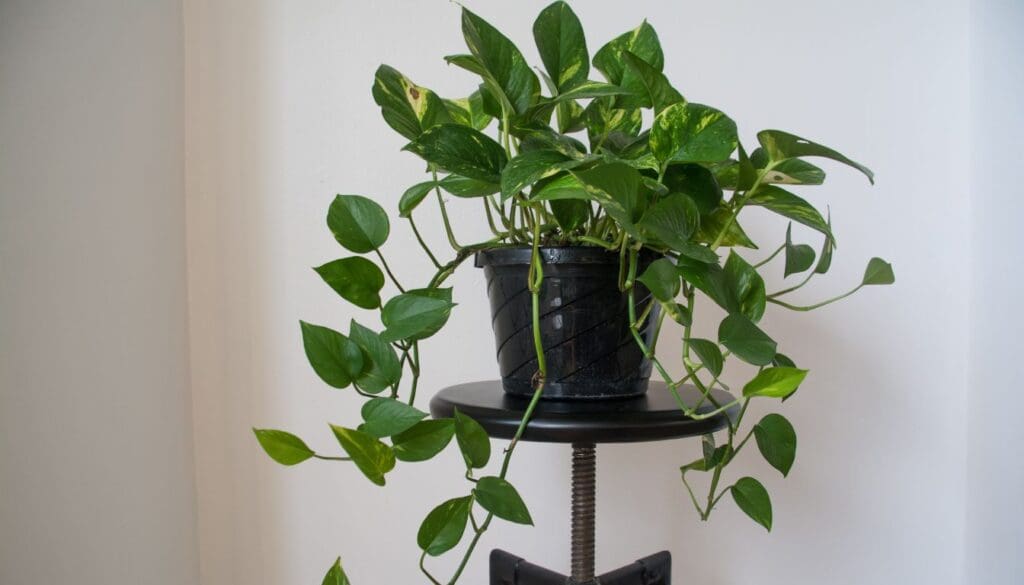10 Tips to Make a Pothos Climb: Simple Tricks for Stunning Indoor Vines
Have you ever seen a Pothos plant gracefully climbing up a wall or a support pole? These plants can turn any indoor space into a mini jungle!
Whether you’re a plant newbie or a seasoned gardener, making your Pothos climb can be both an easy and rewarding task. 🌿
From improving home decor to enhancing the plant’s health, getting your Pothos to grow upwards has many benefits.
Imagine your Pothos trailing up a shelf or spiraling around a pole. Intrigued?
Let’s dive into some simple strategies to help your Pothos become a climbing masterpiece! 🪴✨
Please note: Simplify Plants is reader-supported. As an Amazon Associate, I earn from qualifying purchases made by our readers with no extra cost added to you all! Some links in the post are affiliate links and I get a commission from purchases made through links in the post.
1) Provide a Trellis

One of the best ways to make a pothos climb is by using a trellis.
Think about your living space and how you’d like to decorate it. A trellis can be a stylish addition that also helps your plant thrive.
There are so many options to choose from, like bamboo canes, metal poles, or even a moss pole.
I love how a bamboo trellis adds a natural vibe to my room. It’s simple to set up and gives the pothos something to latch onto as it grows.
Don’t have bamboo? No problem! You can use a metal trellis, which is sturdy and sleek. I’ve seen people get creative with old tomato cages as well. 🤯
Another fun idea is using wooden hoops. They can make your plant look like it’s part of a mini jungle gym!
Just loop the vines around the hoops and secure them with some soft string or twine. If you’re feeling crafty, you can even make a popsicle stick trellis. It’s a fun project and adds a quirky touch to your decor.
A moss pole is a fantastic choice for growing those impressive big leaves that everyone loves. It provides a soft surface for the aerial roots to cling to and keeps the vines stabilized.
I personally think moss poles give the pothos a majestic appearance. 🌿
Have you tried using a trellis for your pothos yet?
It’s one of my favorite methods because it not only supports the plant but also lets you shape the growth direction.
Share your trellis ideas or experiences in the comments! Maybe you’ve come up with some creative ways to help your plant climb? 🪴
2) Use Command Hooks
One of the easiest ways to make your pothos climb is by using command hooks. These handy hooks stick to the wall without causing damage, making them perfect for renters or anyone who doesn’t want to leave holes.
First, decide where you want your pothos to climb. Think about the light source. 🌞
Pothos love bright, indirect light, so choose a spot where they can soak up some rays without getting scorched.
Next, grab a few command hooks. I like the clear ones—they blend in better.
Place them on the wall in a pattern your pothos can follow. You can go straight up, make a zigzag, or create your own unique design. 🎨
Once your hooks are in place, gently guide the vines around them.
Be careful not to pull too hard; pothos vines can be delicate.
Use the hooks to support long vines, and let them wrap around naturally.
Command hooks are also super helpful for training your pothos on trellises or other supports. Just attach the hooks to the support and wrap the vines around them. It gives the plant the structure it needs to climb.
Do you have a favorite way to make your pothos climb? Or maybe a fun design for your vines?
Share your ideas in the comments below! 🌿✨
Using command hooks is a simple and effective way to get your pothos climbing. It’s like giving your plant a little guidance on its journey to become a beautiful, green wall piece.
3) Train with Soft Ties

One way I love training my pothos to climb is by using soft ties.
It’s important to be gentle with the vines to avoid damaging them. I normally use plant ties, twist ties, or even old fabric strips. 🌿
To get started, I simply tie the vines to a support like a trellis or a stick.
I make sure the ties are loose and not too tight. This way, the vines can grow freely without being constricted. Have you ever tried this? It works wonders!
When I’m choosing where to tie, I focus on areas where the vines naturally want to cling.
I attach the ties every few inches to guide the plant up the support. Do you have any favorite supports to use for your plants? I find hooks or nails also work well in some cases.
Training a pothos to climb does require a little patience.
Checking the ties regularly is key to making sure they are still secure but loose enough for the vines to breathe. 🪴
Curious about other people’s experiences? Share your tips below!
Keeping the vines tied at regular intervals ensures that the plant grows in the direction I want.
It’s almost like creating a green masterpiece on my wall. What shapes or patterns have you tried? I’d love to hear your creative ideas! 🌱
4) Choose the Right Pot
Picking the right pot for your Pothos is super important! 🚀
Always go for a pot with drainage holes. This ensures that extra water can escape, preventing root rot. No one wants a sad plant with soggy roots.
Another thing to check is the size. Start with a pot that’s about 2 inches wider than the current one. If your Pothos is root-bound, consider going even a tad bigger. But don’t overdo it. A pot that’s too large can make it hard for the plant to stabilize.
Material matters too! I prefer ceramic pots because they’re sturdy and look so pretty.
Plastic pots can work, but they retain more moisture, which can be tricky. If you’re new to plant parenting, a ceramic or terracotta pot might be your best bet.
Have you ever seen those cute hanging pots? 🌿 They’re perfect if you’re tight on space. Plus, they make your Pothos look like it’s cascading down from the heavens.
Lastly, consider the pot’s color and design. Make it a part of your home decor! Pick something that makes you smile every time you see it. Who says plant care can’t be stylish?
What kind of pots do you use for your plants? Drop your favorite pot pics in the comments! 📸🌱
5) Ensure Proper Lighting

When it comes to making my pothos climb, lighting is super important.
Pothos plants thrive in bright, indirect light.
Imagine giving your plant a cozy spot where it gets plenty of sunlight filtered through a curtain. 🌞
If you put your pothos in too much direct sunlight, the leaves might burn. I’ve seen this happen, and it’s not fun! 😢
On the other hand, if the plant doesn’t get enough light, it might start to look sad and won’t grow much.
Placing the pothos near a window that doesn’t get direct sunlight all day is ideal.
I usually put mine near an east-facing window. It’s like the perfect morning sun bath without the risk of sunburn!
I sometimes use grow lights, especially during the darker months.
These lights mimic the sun and help my pothos grow strong. It’s like giving them a little sun on a cloudy day. 🌤️ Plus, I can control how much light they get!
Have you ever tried placing your pothos under grow lights?
It could make a big difference in their growth! It’s like a magic trick for plants. 🎩✨
Fun fact: Pothos naturally grow toward the light. So, if you want them to climb up a pole or wall, place a light source above them. 📈 It’s like they’re reaching for the stars!
Don’t forget to share your thoughts with me! How do you light up your pothos? Let’s chat in the comments! 🌿💚
6) Water Consistently
Keeping your Pothos well-watered is key to helping it thrive.
When I first started growing Pothos, I noticed they tend to prefer a consistent watering schedule.
Aim to water your plant every 1-2 weeks. Letting the soil dry out a bit between waterings is a good practice.
It’s important to avoid overwatering. Pothos don’t like sitting in soggy soil. 🚫
If you’re unsure, stick a finger into the soil about an inch deep. If it feels dry, it’s time to water!
I always use room temperature water for my plants.
Cold water can shock the roots and warm water can encourage bacterial growth. Keeping the water just right helps my Pothos stay happy and healthy. 🌿
Have you tried using a self-watering pot?
These can help maintain a consistent water level for your Pothos. It’s a neat trick for those of us who sometimes forget when we last watered our plants! 😉
Share your watering tips in the comments below! Do you have any funny watering mishaps? 🌱💦✨
7) Fertilize Regularly

Feeding your pothos helps it grow strong and healthy.
I usually fertilize my plant 2 to 4 times a year. This gives it the nutrients it needs, especially during the growing season. 🪴
When should you fertilize? Spring and summer are great times because that’s when the plant is most active.
Use a balanced, water-soluble fertilizer and follow the instructions on the package. 🌱
Have you ever wondered why your pothos isn’t growing as fast as you’d like?
Lack of nutrients might be the reason. Feeding your plant helps it develop lush, vibrant leaves and longer vines. 🌿
I once skipped fertilizing my pothos, and it didn’t grow much that year. Lesson learned! 😅
Now, I’m consistent with feeding it, and the results are amazing.
Do you have any tips or tricks for fertilizing? Share your experiences in the comments! 💬
Remember, a little goes a long way.
Too much fertilizer can harm your pothos, so it’s better to stick to the recommended schedule. Your plant will thank you with beautiful, climbing vines! 🌟
8) Maintain Humidity

Pothos plants love humidity! 🪴
To keep them happy, aim to maintain moderate humidity levels around them. This means keeping it around 50-60%.
One easy tip is to mist the leaves once or twice a week. It’s like giving your plant a little spa treatment! 🌟 Just spray some water on the leaves and around the plant.
If you live in a dry area, consider using a humidifier.
It can be a game-changer, especially in the winter. Place the humidifier near your Pothos, and you’ll see it thrive.
Another trick is to place a tray of water with pebbles under your plant.
As the water evaporates, it adds some moisture to the air. It’s a simple but effective way to boost humidity!
Ever notice your plant looking a bit sad? Check the humidity. Sometimes, just a little extra moisture in the air can make a huge difference. 🌿
Do you have humidifiers or prefer misting your plants? Share your tips below! 💬
9) Rotate the Pot Regularly
Did you know that rotating your pothos pot is super important?
Your pothos loves to soak up light, but just like us, it needs a bit of a change in perspective every now and then.
Every couple of weeks, I give my pothos pot a little spin. This ensures that all sides of the plant get a good dose of light.
Otherwise, your pothos might start growing lopsided, with most of the leaves facing the window.
By turning the pot regularly, all parts of the plant will grow evenly. Plus, it helps prevent those long, lanky vines that can happen when only one side gets light. Who doesn’t want a fuller, healthier plant, right?
Another perk? It’s a great time to check up on your plant. Look for yellowing leaves, pests, or anything out of the ordinary.
It’s like a mini health check-up for your pothos!
Have you tried rotating your pot yet? 🪴 Give it a whirl (literally) and let me know how your pothos reacts in the comments below! 🌟
10) Clean the Leaves

Keeping the leaves of your pothos clean is super important! Dust can block light from reaching the plant, making it harder for the plant to grow strong and healthy. Plus, clean leaves just look nicer. 😄
I like to use a soft cloth or a sponge that’s slightly damp.
Gently wiping each leaf removes dust and grime. Be careful not to scrub too hard, as the leaves can be delicate.
Think of it as giving your pothos a little spa day. 🌿 Sometimes, I even talk to my plants while I clean their leaves. They deserve the love, right?
Why not make it a fun weekly routine? I usually do it on Sundays. ✨ Do you have a preferred day for plant care? Let me know in the comments!
In addition to making the plant look good, clean leaves help keep pests away. Dusty leaves can attract spider mites and other pests, which nobody wants. 🕷️
Remember, happy leaves mean a happy plant! And a happy plant means a happy plant owner. 💚 Have you noticed a difference in your pothos after cleaning the leaves?
Pro Tip: Sometimes, I add a tiny drop of mild dish soap to the water for an extra-clean finish. Just make sure to rinse the leaves after to avoid any soap residue.
Who’s ready to give their pothos a good clean? Drop a leaf emoji in the comments if you’re on board! 🌱
Understanding the Growth Habit of Pothos

Pothos plants are naturally inclined to climb, using their aerial roots to attach to surfaces. They thrive in bright, indirect light and grow best when given something to climb, like a moss pole or trellis.
Natural Climbers: How Pothos Climb in Nature
In their native tropical habitats, Pothos plants are expert climbers. They use strong aerial roots to grab hold of tree trunks and other surfaces. This helps them reach for more light, essential for photosynthesis. 🌿
Imagine being a Pothos in the jungle—climbing higher means less competition for sunlight.
As they climb, their leaves often grow larger and more vibrant. The aerial roots absorb moisture from the humid air, supporting the plant’s growth.
Next time you look at your own Pothos, think about how amazing it is that they climb so well in the wild. Why not give them the chance to show off those skills in your home?
Comparing Pothos to Other Climbing Plants
Pothos are special, but they aren’t the only climbing plants out there. For example, ivy and philodendrons also climb, but they have different techniques. 🍃
Philodendrons often grow thicker stems and use aerial roots like Pothos. Ivy, on the other hand, has small, sticky pads that cling to surfaces. Pothos don’t do that; they rely on wrapping their stems around structures.
Compared to ivy, Pothos are easier to train on objects like moss poles and trellises. Their versatility makes them great for both beginners and seasoned plant lovers. Each time you see a Pothos climbing, remember it’s a natural superstar in the plant world!
Have any thoughts on how your Pothos are climbing? Share them in the comments below! 🌱✨
Preparing Your Pothos for Climbing

Getting your pothos ready to climb involves selecting the right support and ensuring the plant is well-pruned and healthy. These steps will guide you through the process and set your pothos up for success! 🌿
Choosing the Right Support Structure
First things first, pick a sturdy support for your pothos. The most popular choices include moss poles, trellises, and wall hooks. Each one has its perks.
Moss poles provide a natural look and help keep the vines hydrated. Trellises work well if you want the plant to spread out more. Wall hooks offer the most flexibility, letting you choose the exact path for your vines.
Example: I went with a moss pole for my pothos – it’s amazing to watch the roots cling to it! 😍
Think about where you’ll place your pothos. Bright, indirect light is best, and the support structure should be secure in its spot.
Nobody wants a crashing plant! If you’re going vertical, ensure there’s room for the vines to grow upward without hitting the ceiling too soon.
Trimming and Pruning for Optimal Growth
Before your pothos starts its climb, do some trimming and pruning.
Check for damaged or yellow leaves and snip them off with clean scissors. This not only makes your plant look better but also focuses its energy on healthy growth.
Remember to prune the stems to control the shape. Cutting just above a leaf node (where the leaf meets the stem) encourages new growth. This makes your pothos fuller and bushier. ✂️
Pro Tip: Don’t throw away those cuttings! You can propagate them in water to grow new plants. How cool is that?
Also, give your pothos a good watering a day before you start training it. This reduces transplant stress and keeps the vines flexible.
How do you prepare your pothos for climbing? Any favorite tips or stories? Share in the comments below! 🌱👩🌾
Encouraging Pothos to Climb Indoors
Training a Pothos to climb indoors can transform your space into a lush, green haven. Here’s how to guide your Pothos and keep it thriving with the right care.
Training Techniques: Guiding the Vines
To help Pothos vines climb, I start by selecting a support system like moss poles, trellises, or command hooks. These structures provide a sturdy base for the vines to cling to.
First, I gently tie the vines to the support using soft plant ties or strings. 🤚 It’s important to be gentle to avoid damaging the plant.
Next, as the plant grows, I continue to train the vines by wrapping them around the support. This encourages the Pothos to grow upwards and attach itself.
Do you have any creative support structures you’ve used for your plants? 🌿 Share below!
Proper Lighting and Watering for Healthy Climbing
Good lighting is crucial. I place my Pothos in a spot with bright, indirect light. Too much direct sunlight can scorch the leaves, so I avoid that. 💡
For watering, I keep the soil moist but not soggy. Overwatering can lead to root rot, which isn’t great for any plant. I use my finger to check the soil’s moisture level regularly.
Fertilizing is also key.
I feed my Pothos 2-4 times a year, especially during its active growing season. This helps the plant stay healthy and strong, making it more likely to climb successfully.
Have you tried any specific fertilizers that worked wonders? Let me know in the comments! 🌱
Encouraging Pothos to climb indoors isn’t just about looks—it’s about giving the plant the right care and support. 🧗♂️
FAQs
Q: How do I get my Pothos to climb?
A: Keep it simple! I like to use support structures like moss poles or trellises. Just attach the stems as they grow.
Q: Where should I place my Pothos?
A: Bright, indirect light works best. Avoid direct sunlight; it can burn the leaves. Got a perfect spot in mind? 🌞
Q: How often should I water my climbing Pothos?
A: I usually water mine when the top inch of soil feels dry. Don’t overdo it! Too much water can lead to root rot. 💧
Q: Do I need to fertilize my Pothos?
A: Yep! Fertilize 2-4 times a year during the growing season. Your Pothos will love you for it!
Q: Can I train any Pothos variety to climb?
A: Absolutely! Whether it’s a Golden Pothos or a Marble Queen, they can all be trained to climb. 🎍
Q: What are some common problems with a climbing Pothos?
A: Watch out for yellowing leaves (could mean too much water) and leggy growth (might need more light). Need any more tips?
Q: How do I attach my Pothos to a wall?
A: I like using command hooks, brass picture hooks, or wrapping the vines around a wire. Super easy!
Got any more questions? Share in the comments! Plus, I’d love to see your climbing Pothos pics! 📸🌿
Conclusion
Helping your pothos climb can turn your ordinary plant into a showstopper! 🌿
Choose a spot with bright, indirect light and avoid heat sources.
It’s amazing how much a little care can make a difference.
I’ve found that using moss poles can really help the leaves grow bigger and healthier.
For those who want simple solutions, 3M command hooks or brass picture hooks work wonders.
Just tie the vines, and watch them transform your walls!
Don’t forget to fertilize your pothos a few times a year to keep it happy and healthy.
As it grows, secure the vines and trim them as needed to maintain shape.
I enjoy seeing the progress of my pothos every day. It’s really rewarding and therapeutic.
Have you tried training your pothos to climb? Share your tips or questions in the comments! 🌱✨
Note: Some images in the articles are sourced from Reddit and Other Platforms For Reference Purpose.






